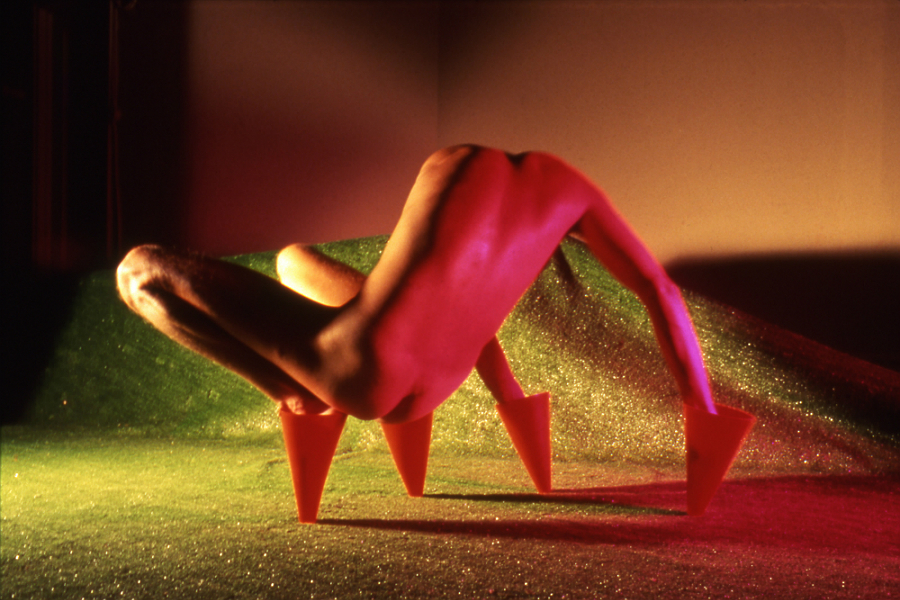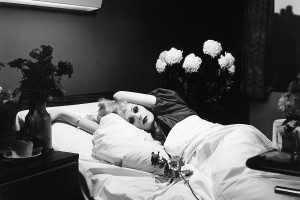Glam! The Performance of Style

A critical assessment of the Glam era? We went looking for meaning in The Performance of Style at Tate Liverpool…
The thing about glam is that, for us, the word conjures up images of glitter bands miming on Top of The Pops, with a greater emphasis on dress up, teeny boppers and mainstream accessibility, than it does a culturally significant movement still resonating today.
So Glam! The Performance of Style, Tate Liverpool’s new exhibition, would either be the ultimate confirmation on a lifetime of preconceptions, or the impetus for a rather drastic and embarrassing about-face. Entering the gallery at the press call, we’re met with a wall of memorabilia: Glamscape UK, as curator Darren Pih has called it (the exhibition is arranged thematically), while David Bowie’s Moonage Daydream is emanating from somewhere.
As introductions go (Bowie being a favourite of ours), things couldn’t have got off to a much better start, despite feeling pretty overwhelmed by that Glamscape, containing as it does 94 pieces of ephemera; record sleeves, gig and film posters and photos – it’s a lot to take in. Guiding us through the exhibition, Pih tells us he sees glam as the “convergence of arts, style and life… androgyny [and] challenging agendas” and our press packs explain that through this show, “the Glam era… is critically evaluated”.
Certainly, there is a sense of the convergence Pih mentions, as David Hockney’s luxuriously louche Mr and Mrs Clark and Percy (depicting fashion designer Ossie Clark and textile designer Celia Birtwell) rubs shoulders with Richard Hamilton’s Swingeing London and photographs of Nice Style: The World’s First Pose Band, but as we take our guided tour, we begin to wonder where that critical evaluation will fit in.
Before we can wonder any more, we arrive at Marc Camille Chaimowicz’s installation Celebration? Realife, which proves to be the source of that wonderful Bowie track we mentioned earlier. A whole room is given over to the piece (first produced in 1972) which Chaimowicz has recreated with a 2013 twist; introducing a stray shoe found by the artist in Liverpool. Pih, who described it in a Guardian interview as the “ultimate glam rock artwork”, remarks that it is “stunning.” We can only guess at what he sees in it that we’re missing; to us, the piece (with detritus and mirror balls strewn about the place) peaked at the soundtrack.
Onwards, and it begins to strike us we’re unsure to what extent Glam! is an exhibition, collection of memorabilia, or genuine assessment of the period. Meanwhile, Pih is saying interesting things about how progressive the period was, and that it successfully challenged established gender stereotypes; and sure, when Bowie (that man again) appeared on the sleeve art of The Man Who Sold The World (released in the UK in 1971), looking beautifully fey in a dress, eyebrows were certainly raised. Perhaps, but no matter how good he may have looked, this comes back to our thoughts of glam being more about dress up than anything, and Pih’s casual assertion that glam was “more meaningful than punk”, looks shaky to say the least.
Indeed, without looking too hard for them, there are examples in the exhibition which seem to confirm our thoughts about glam’s inherently shallow nature. Canadian collective General Idea, talking about their practice (with no small amount of parody), stated in the Glamour issue of their publication, FILE: “We wanted to be famous, glamorous, and rich. That is to say we wanted to be artists, and we knew that if we were famous and glamorous we could say we were artists and we would be.” The statement continued: “We never felt we had to produce great art to be great artists. We knew great art did not bring glamour and fame.” Somehow, and very knowingly, General Idea encapsulated the post-modern artifice of glam perfectly.

We’re sure the game is really up when confronted with Peter Hujar’s Candy Darling on her Deathbed (above). The transsexual Warhol superstar Darling, muse to Lou Reed (she was the subject of both Walk on the Wild Side and Candy Says), and literally on her deathbed, left a note for Warhol declaring: “too empty to go on in this unreal existence” and being “bored… you might say bored to death.”
Don’t get us wrong, there’s a lot to see in Glam! The Performance of Style, and on those terms – particularly if you’re interested in the era – we say go and take a look. But ultimately, even the most interesting pieces of the show amount to so much memorabilia, and we’re left wondering what percentage can actually be referred to as ‘art’.
Perhaps the period is best left to biographers. You want, need, to know more about Candy Darling and her contemporaries if they are to be done any real justice. Certainly, there’s a lot more to be gleaned reading about the movers and shakers so intrinsically linked to the era than simply looking at artful shots of Lou Reed, The New York Dolls, et al. As nice as that is, you want to get under the skin of these images, and ultimately, you feel this is something Glam! The Performance of Style fails to do. Plus, we never did decide just where the critical analysis takes place.
Glam! The Performance of Style continues at Tate Liverpool until 12th May £8





